Taxonomy: Class: Mammalia; Order: Rodentia; Family: Muridae
Description
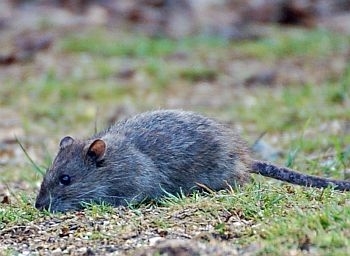
Brown rat © Peter Thompson
The brown rat, also known as the common or Norway rat, is thought to originate from central Asia. Highly adaptable and long associated with man's activities, it spread across Europe and into Britain in the 18th century, largely displacing the black rat (also called ship rat) that had been present since Roman times. It is a pest of stored food, a vector of human diseases and a predator of birds' eggs and chicks.
Rat control may take place at any time of year. Since the Second World War, poison became the favoured means of control, with the consequence that most rats die underground and their numbers are not reported. NGC returns are thus underestimates, and refer mainly to rats shot or caught in tunnel traps. They also do not include urban rats, so trends should be interpreted with caution.
Further information:
Mammal Society website brown rat page.
Conservation status and legislation
Status:
UK: Non-native
World: Least Concern (IUCN Red List)
Legislation:
Distribution and abundance
The brown rat occurs throughout Britain and on all offshore islands except for a few of its smallest ones. It is least common in exposed upland areas. It also occupies the whole of Ireland, despite the paucity of records on the map.
Estimates of brown rat abundance (numbers of individuals in the spring) across the UK, from Harris et al. (1995):
Recent trends from the National Gamebag Census
United Kingdom
Index of bag density from 1961 to 2009 (see statistical methods and interpretational considerations).
Error bars represent 95% confidence intervals.
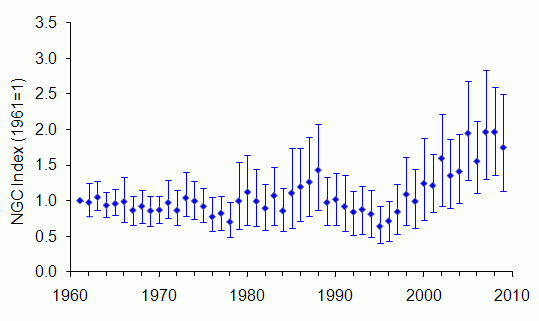
The bag index was broadly stable until the 1990s, when it began to increase. Overall, this means that the bag index has doubled between 1961 and 2009. The increase matches the widespread perception that rats have been much more numerous recently, and it is possible that a series of mild winters boosted survival.
Change in brown rat bags over time, with 95% confidence limits (see statistical methods):
| Country |
Sites |
Start
year |
End
year |
Change (%)
1961-2009 |
Change (%)
1984-2009 |
Change (%)
1995-2009 |
| United Kingdom |
940 |
1961 |
2009 |
95*
33 to 164 |
89*
46 to 150 |
112*
56 to 190 |
* significant at P < 0.05
England
Index of bag density from 1961 to 2009 (see statistical methods and interpretational considerations).
Error bars represent 95% confidence intervals.
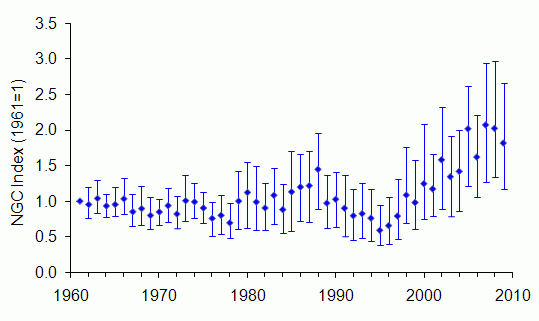
The bag index was broadly stable until the 1990s, when it began to increase. Overall, this means that the bag index has doubled between 1961 and 2009. The increase matches the widespread perception that rats have been much more numerous recently, and it is possible that a series of mild winters boosted survival.
Change in brown rat bags over time, with 95% confidence limits (see statistical methods):
| Country |
Sites |
Start
year |
End
year |
Change (%)
1961-2009 |
Change (%)
1984-2009 |
Change (%)
1995-2009 |
| England |
720 |
1961 |
2009 |
104*
35 to 191 |
97*
50 to 174 |
130*
56 to 214 |
* significant at P < 0.05
Scotland
Index of bag density from 1961 to 2009 (see statistical methods and interpretational considerations).
Error bars represent 95% confidence intervals.
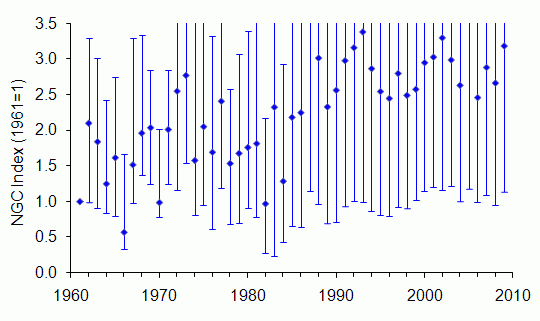
The bag index has doubled between 1961 and 2009, but the error bars on the estimated values are so large that it is not possilbe to detect a significant change. The apparent increase matches the widespread perception that rats have been much more numerous recently, and it is possible that a series of mild winters boosted survival.
Change in brown rat bags over time, with 95% confidence limits (see statistical methods):
| Country |
Sites |
Start
year |
End
year |
Change (%)
1961-2009 |
Change (%)
1984-2009 |
Change (%)
1995-2009 |
| Scotland |
178 |
1961 |
2009 |
110
-26 to 511 |
36
-31 to 174 |
4
-39 to 76 |
* significant at P < 0.05
Wales
Index of bag density from 1961 to 2009 (see statistical methods and interpretational considerations).
Error bars represent 95% confidence intervals.
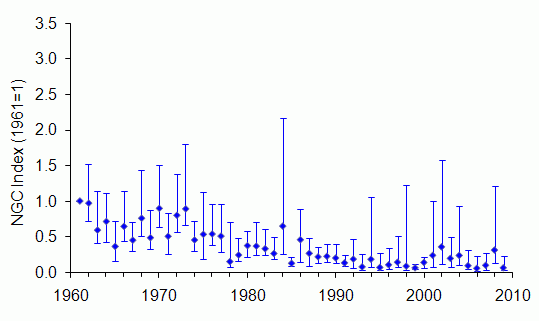
Since the start of the series, the bag index declined steadily until the 1990s. As a result, there has been an overall significant decline between 1961 and 2009. It is not known why the trend is so different from that in other parts of the country.
Change in brown rat bags over time, with 95% confidence limits (see statistical methods):
| Country |
Sites |
Start
year |
End
year |
Change (%)
1961-2009 |
Change (%)
1984-2009 |
Change (%)
1995-2009 |
| Wales |
30 |
1961 |
2009 |
-81*
-93 to -39 |
-51
-81 to 44 |
7
-60 to 61 |
* significant at P < 0.05
N Ireland
There are too few bag records of brown rat to produce an index graph. 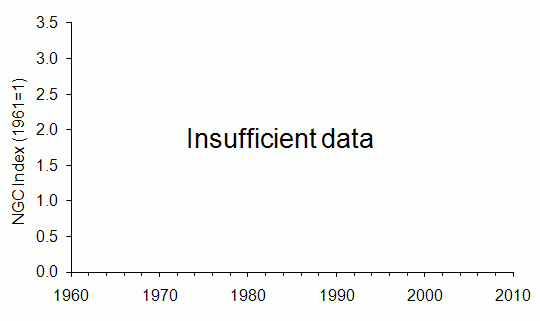
There are too few bag records of brown rat to evaluate rates of change over time
| Country |
Sites |
Start
year |
End
year |
Change (%)
1961-2009 |
Change (%)
1984-2009 |
Change (%)
1995-2009 |
| N Ireland |
Too few sites |
Environmental zones
Change in brown rat bags over time, with 95% confidence limits (see statistical methods):
| Environmental zone |
Sites |
Start
year |
End
year |
Change (%)
1961-2009 |
Change (%)
1984-2009 |
Change (%)
1995-2009 |
| Easterly lowlands (England/Wales) |
458 |
1961 |
2009 |
105*
37 to 197 |
91*
45 to 195 |
127*
47 to 228 |
| Westerly lowlands (England/Wales) |
191 |
1961 |
2009 |
33
-55 to 108 |
34
-45 to 170 |
56
-28 to 190 |
| Uplands (England/Wales) |
93 |
1995 |
2009 |
no data |
no data |
318*
168 to 553 |
| Lowlands (Scotland) |
59 |
1961 |
2009 |
137
-51 to 1047 |
-11
-68 to 112 |
-35
-75 to 54 |
| Intermediate uplands/islands (Scotland) |
34 |
1961 |
2009 |
3
-43 to 75 |
11
-36 to 114 |
54
-16 to 172 |
| True uplands (Scotland) |
87 |
1961 |
2009 |
-13
-71 to 129 |
40
-46 to 298 |
16
-41 to 212 |
* significant at P < 0.05
Comparison with BBS mammal data
No comparison with the NGC trend is possible because too few brown rat records are received through the Breeding Bird Survey (BBS) organised by the British Trust for Ornithology.
Long-term trend from the National Gamebag Census
There are too few bag records of brown rat to produce a trend starting before 1961.
References and further reading
- Battersby,J. (2005). UK Mammals: Species Status and Population Trends. Joint Nature Conservation Committee/Tracking Mammals Partnership, Peterborough (JNCC download page).
- Harris,S., Morris,P., Wray,S. & Yalden,D.W. (1995). A Review of British Mammals: Population Estimates and Conservation Status of British Mammals Other than Cetaceans. Joint Nature Conservation Committee, Peterborough (JNCC download page).
- Harris,S. & Yalden,D.W. (2008). Mammals of the British Isles: Handbook, 4th edition. Mammal Society, Southampton.
- Hart,M. (1982). Rats. Allison & Busby, London.
- Meehan,A.P. (1984). Rats and Mice: Their Biology and Control. Rentokil, East Grinstead.
- Twigg,G.L. (1975). The Brown Rat. David & Charles, London.
This report should be cited as: Aebischer,N.J., Davey,P.D. & Kingdon,N.G. (2011). National Gamebag Census: Mammal Trends to 2009. Game & Wildlife Conservation Trust, Fordingbridge (http://www.gwct.org.uk/ngcmammals).
Return to species list